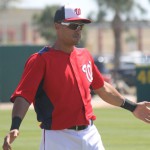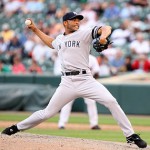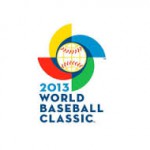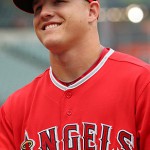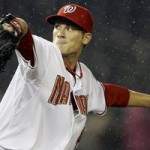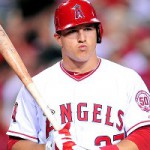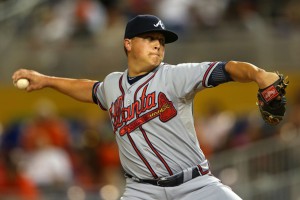Another month, another .500 record for the Nats. At the halfway point they’re 41-40, on pace for a fantastic 82-80 record. Well, the Cardinals won the World Series a few years back making the post-season 83-79, so maybe all is not lost (sarcasm). Though, the last couple days have seen unprecedented offensive output (they’ve scored 10+ runs twice in a row after only having done it once prior).
Bryce Harper is back after missing nearly 5 weeks of games (and hitting badly through another 4 weeks in May of them before that), and promptly hits a homer in his first AB off the D/L. With Harper’s inclusion, we’ll finally see the “ideal offensive lineup” that I touched on last week. On paper, a 2-7 of Werth-Harper-Zimmerman-LaRoche-Desmond-Rendon looks really, really good.
In this light, lets see what kind of baseball questions Tom Boswell took in his pre-holiday chat on 7/1/13. As always, I’ll write my answer here before reading his to avoid bias and edit questions for clarity (since a lot of the “questions” he takes are rambling complaints about this or that).
Q: Are the Nationals as a team missing the “spark” they need to rally for the playoffs?
A: I’ve talked about the outflow of “chemistry” this team lost when Michael Morse was dealt before. I’ve also speculated in this space before about whether or not this team has too many “uber serious” players. In many ways winning consistently creates “chemistry” but I also think the reverse is true if you don’t have the right guys with leadership voices in the clubhouse. Is the return of one hitter (albeit their best) going to change the tune for this team? Boswell notes that the team faces a significant hole: 6.5 games in the division, 5.5 games just for the wild-card coin flip game.
Q: Thoughts on Taylor Jordan? Does he get a 2nd Start?
A: See here for my post over the weekend on Taylor Jordan, and Yes he gets a 2nd start. He only gave up one earned run. Lets see what Boswell said: Boswell has a good point: he liked Jordan, thought he had potential .. but then noted that this team needs to go 50-31 to make the playoffs and you’re not going to go 50-31 with a rookie as your 5th starter.
Q: With Werth appearing to be injured, do you see Davey moving Harper to right and Werth to left field?
A: Well, this is one of those “veteran manager” moves from Davey Johnson that gets me sometimes. I believe that Jayson Werth is inarguably a lesser fielder than Harper (who would be playing center for nearly every other team in the league by virtue of his range and arm). Harper’s arm is one of the best in the league. He’s younger, faster and covers more ground (excellent range per UZR/150 numbers in center last year). So why is Werth in right? Because he’s the vet. Harper won’t take over RF until Werth advances in age or gets a new manager who isn’t afraid to move him and his 9 figure salary to the position he should be in. I disagree with Boswell’s opinion on this one; he thinks Werth is the more polished OF and that Harper got hurt playing RF. As if he wouldn’t have run into a wall eventually playing elsewhere.
Q: Do we need alterations to the Balk rule?
A: At some level yes. I think there’s a huge difference between some slight bobble in your motion and a blatant attempt to deceive the runner by “flinching” or doing a purposeful stop-start head motion. Its the difference between inadvertant and purposeful deception. And the embarassing umpire “Balking” Bob Davidson needs to be reigned in. Plus, nearly every left-handed pitcher uses a “balk move” to first on a regular basis, almost never stepping directly at the bag. And when was the last time you saw a right-hander get a balk call for throwing over to first while bending his right leg? But, in the grand scheme of things I’m not sure the Balk rule is the great scourge of our modern game (see ball-strike zone consistency, instant replay, ongoing PED issues, and salary discrepancies making the league a group of haves and have-nots). Boswell doesn’t understand the Balk but loves it.
Q: At what point do Zimmerman’s errors accelerate the conversation to move him to 1B?
A: We can start talk about moving Ryan Zimmerman the moment that Adam LaRoche‘s contract runs out. Anthony Rendon can play 2B in the interim and eventually move back over to his natural position. Before then? Somebody would have to get seriously hurt or traded in order to make any modifications to our infield. Boswell points something out I didn’t think about: Zimmerman is playing very shallow because his arm strength is shot … hence why he made those two errors in the saturday Jordan start.
Q: Should we look to trade for Nolasco?
A: I had to laugh; the questioner also asked if the Marlins would pick up his salary. Haha. Have you not see the M.O. for Jeffrey Loria by now? Hoard every nickle in every deal. That being said, I think we’d have the biggest chance of trading intra-division with Miami versus anyone else; they seem to be amenable to take back less in return for taking salary off their hands (see the Willingham/Olsen deal a while back).
A better question; should we be forcing a trade for pitching at all? Even with the Dan Haren issues all year the team is 5th in the majors in ERA (10th in adjusted ERA+). Of course, the four teams above us are all either divisional rivals or challengers for the wild card. But the point is this: you need to fix what’s wrong, and the pitching overall isn’t what’s wrong. Its offense. Its bench production. Its hitting. Trade for something that helps fix the problem. Boswell just talks about how we have enough money and how we shouldn’t give up any decent prospects.
Q: Is there a stat that shows how many a player’s errors relate directly to runs scored?
A: Unearned runs? Except I’ve never seen someone directly tie the two together. Therefore probably not, because this type of research likely will have a Sabre-tinged analyst immediately say, “I’m not doing that because Errors are not the best way to measure fielders.” Then they’ll point at (in this case speaking of Zimmerman) his UZR/150 (an awful -20.2 for 2013 thus far), his Defensive Runs Saved (strikingly he’s actually cost the team 2 runs so far, projecting for a -4 rDRS for the year) or his Fielding Runs Above Average (FRAA) which measures out at 3.0 so far in 2013, slightly above average. My narrative on Zimmerman’s steep decline this year in range and defensive metrics goes as follows: nursing leg injuries and forced to play further up, Zimmerman’s not making the plays he normally would, which is being reflected in his UZR decline. Meanwhile FRAA correctly measures that he’s still a slightly above average fielder. Boswell doesn’t know.
Q: With Harper coming back, I’m assuming that Rendon slides down to seventh. Is that the best place for him? Also, is he too good of a hitter to bat seventh? With Ramos coming back soon, does this make the Nats a much more dangerous offensive team?
A: I’m not so sure I’d move Rendon down; he’s the absolute prototypical #2 hitter. He hits to all fields, he’s especially good at hitting to right, he’s got a .360 OBP, and is a great tablesetter for the 3-4-5 guys. No, I think you move everyone else down a spot. Of course, that being said, if you had a manager with any cajones, he’d move Werth to the #7 spot since everyone else in this equation is a better hitter right now. But it won’t happen, so either Ian Desmond or Rendon likely moves to #7.
With Wilson Ramos back as I’ve noted in this space, yes this should finally let the Nats put out their best, strongest lineup. Boswell says Werth bats #2, pointout his OBP is .330. I’ll now point out that that OBP is 10% less than Rendon’s right now. But I can’t argue with Boswell’s point that Rendon could use the pressure taken off of him … until you remember that Harper didn’t seem to have any issues batting #2 all year last year. Update: Boswell called it right: Werth is batting #2 upon Harper’s return.
Q: Why would Davey claim the Lerners want him out?
A: That’s a reasonable conclusion from reading Mike Wise‘s article over the weekend. He seems to intimate that the ownership group is frustrated with the team’s performance this year and puts some of it at Johson’s feet. At least that’s the way Johnson interprets it. Boswell has an interesting point; he says this is a young team and the owners want a manager who can be here for 5-10 years … Johnson is 70 and they don’t see him as the solution.
Q: Should Yasiel Puig be an all-star?
A: If it were me, absolutely yes I’d make Yasiel Puig an all-star, give him an at-bat later in the game. He’s been electric, he’s been the best hitter in the league for half this season. He’s still hitting .436 through 100 at bats!. Having him at the game just makes it more of a fan draw. Boswell thinks he’ll be a late injury replacement. I hope so.
Q: Which team has more wins at the end of 162, O’s or Nats?
A: Easy; the Orioles. They’ve already got a 10 game head start. I don’t think the Nats are going to be 10 games better than Baltimore in the 2nd half. Boswell punts.
Q: Did Desi violate the unwritten code yesterday by slamming a home run into the restaurant when the Mets had a position player on the mound?
A: No way. Of all the unwritten rules out there, the one that is unassailable is that a batter gets a legitimate chance to get a good swing in at the plate no matter what the score. There’s limits (you can’t swing out of your shoes on a 3-0 pitch when winning by 10 runs) but I don’t see how Desmond’s bomb counts. Boswell says Desmond’s HBP earlier negates all rules. Not sure I agree with that reasoning unless the HBP was in any way possible deliberate. Later on another questioner notes that he thought the Desmond HBP was definitely deliberate; I turned the game off when the Nats knocked out Wheeler, figuring they had it sewn up, and didn’t see the fracas.
Q: Why haven’t media such as yourself chastised the Nats for the foolish contracts given to Werth (injury prone, strikeout prone, shaky defensively), Soriano (too much to pay a closer who is not automatic), and Haren? In Philadelphia, all three contracts would have been regarded as somewhere between bad and stupid.
A: Wow. Well, not to re-hash the same reasoning we’ve had over-and-over about these guys, but here goes:
- The Werth deal was an over-pay but also re-established Washington as a player in the FA market, reestablishing credibility that had been destroyed by years of Loria and MLB ownership incompetence. Remember, the same off-season Carl Crawford signed for MORE money and has produced a total of 1.8 war in the last three seasons combined, yet we don’t hear as much about how “stupid” the Boston organization was for that signing. Why does Boston get a pass but Washington doesn’t?
- Rafael Soriano was a luxury item, but I’m not sure its fair to say he’s “not automatic.” He’s blown 3 saves in 24 chances. Jim Johnson leads the league in saves and he’s blown 5. Craig Kimbrel has a 1.48 ERA and he’s blown three himself. I have no problems with Soriano and his contract (other than my general stance against paying top dollars for closers in general … but it wasn’t my money).
- Haren looked like a good signing at the time, was a good risk, and frankly there’s no such thing as a bad one year contract. It wasn’t like we were the only people bidding on him; he was in demand.
Giving power hitters on the wrong side of 30 5 guaranteed years at $25M each? Now that’s a “stupid” contract. Boswell chastises the Philly fan for his media’s overreaction to anything, defending the moves as I have.
